warning JEEP RENEGADE 2018 Owner handbook (in English)
[x] Cancel search | Manufacturer: JEEP, Model Year: 2018, Model line: RENEGADE, Model: JEEP RENEGADE 2018Pages: 356, PDF Size: 6.11 MB
Page 251 of 356
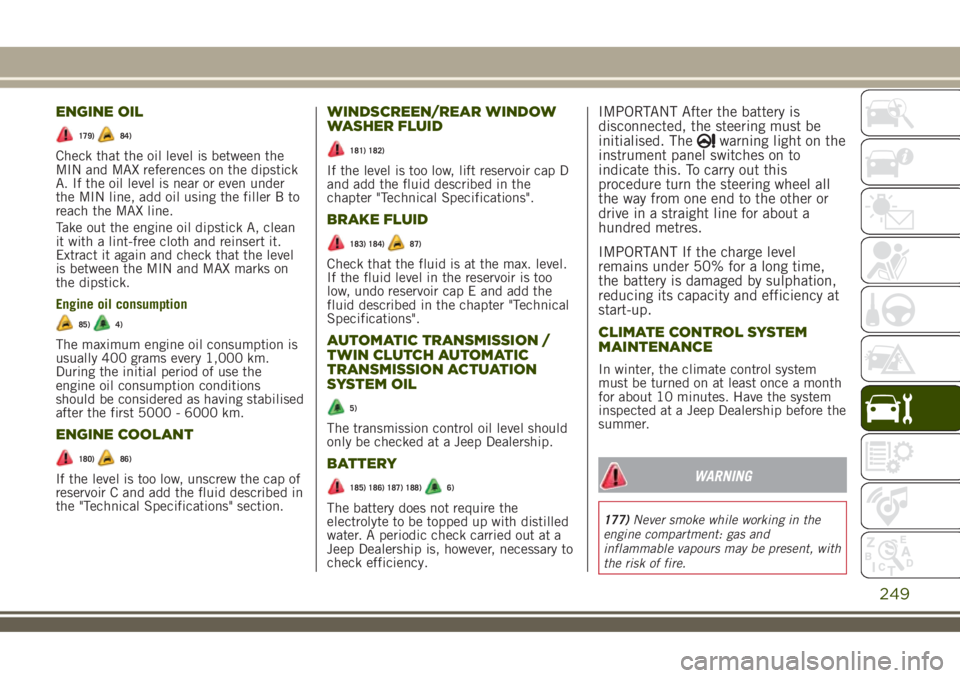
ENGINE OIL
179)84)
Check that the oil level is between the
MIN and MAX references on the dipstick
A. If the oil level is near or even under
the MIN line, add oil using the filler B to
reach the MAX line.
Take out the engine oil dipstick A, clean
it with a lint-free cloth and reinsert it.
Extract it again and check that the level
is between the MIN and MAX marks on
the dipstick.
Engine oil consumption
85)4)
The maximum engine oil consumption is
usually 400 grams every 1,000 km.
During the initial period of use the
engine oil consumption conditions
should be considered as having stabilised
after the first 5000 - 6000 km.
ENGINE COOLANT
180)86)
If the level is too low, unscrew the cap of
reservoir C and add the fluid described in
the "Technical Specifications" section.
WINDSCREEN/REAR WINDOW
WASHER FLUID
181) 182)
If the level is too low, lift reservoir cap D
and add the fluid described in the
chapter "Technical Specifications".
BRAKE FLUID
183) 184)87)
Check that the fluid is at the max. level.
If the fluid level in the reservoir is too
low, undo reservoir cap E and add the
fluid described in the chapter "Technical
Specifications".
AUTOMATIC TRANSMISSION /
TWIN CLUTCH AUTOMATIC
TRANSMISSION ACTUATION
SYSTEM OIL
5)
The transmission control oil level should
only be checked at a Jeep Dealership.
BATTERY
185) 186) 187) 188)6)
The battery does not require the
electrolyte to be topped up with distilled
water. A periodic check carried out at a
Jeep Dealership is, however, necessary to
check efficiency.
IMPORTANT After the battery is
disconnected, the steering must be
initialised. The
warning light on the
instrument panel switches on to
indicate this. To carry out this
procedure turn the steering wheel all
the way from one end to the other or
drive in a straight line for about a
hundred metres.
IMPORTANT If the charge level
remains under 50% for a long time,
the battery is damaged by sulphation,
reducing its capacity and efficiency at
start-up.
CLIMATE CONTROL SYSTEM
MAINTENANCE
In winter, the climate control system
must be turned on at least once a month
for about 10 minutes. Have the system
inspected at a Jeep Dealership before the
summer.
WARNING
177)Never smoke while working in the
engine compartment: gas and
inflammable vapours may be present, with
the risk of fire.
249
Page 252 of 356

178)Be very careful when working in the
engine compartment when the engine is
hot: you may get burned. Do not get too
close to the radiator cooling fan: the
electric fan may start; danger of injury.
Scarves, ties and other loose clothing
might be pulled by moving parts.
179)If the engine oil is being topped up,
wait for the engine to cool down before
loosening the filler cap, particularly for
vehicles with aluminium cap (where
provided). WARNING: risk of burns!
180)The cooling system is pressurised. If
necessary, only replace the plug with
another original or the operation of the
system may be adversely affected. Do not
remove the reservoir plug when the engine
is hot: you risk scalding yourself.
181)Do not travel with the windscreen
washer fluid reservoir empty: the
windscreen washer is essential for
improving visibility. Repeated operation of
the system without fluid could damage or
cause rapid deterioration of some system
components.
182)Some commercial additives for
windscreen washer fluid are flammable.
The engine compartment contains hot
components which may start a fire.183)Brake fluid is poisonous and highly
corrosive. In the event of accidental
contact, immediately wash the affected
parts with water and mild soap. Then rinse
thoroughly. Call a doctor immediately if
swallowed.
184)The symbol
, on the brake fluid
container indicates if a brake fluid is
synthetic or mineral-based. Use of mineral
type fluids will damage the special rubber
seals of the braking system beyond repair.
185)Battery fluid is poisonous and
corrosive. Avoid contact with the skin and
eyes. Keep open flames away from the
battery and do not use objects that might
create sparks: risk of explosion and fire.
186)Using the battery with insufficient
fluid irreparably damages the battery and
may cause an explosion.
187)If the vehicle must remain unused
for a long time at a very low temperature,
remove the battery and take it to a warm
place, to avoid freezing.
188)When performing any operation on
the battery or near it, always protect your
eyes with special goggles.
IMPORTANT
83)Be careful not to confuse the various
types of fluids while topping up: they are
not compatible with each other! Topping
up with an unsuitable fluid could severely
damage your vehicle.
84)The oil level must never exceed the
MAX reference.
85)Do not add oil with specifications
other than those of the oil already in the
engine.
86)PARAFLU
UPanti-freeze fluid is used
in the engine cooling system; use the
same fluid type as that already in the
cooling system when topping up.
PARAFLU
UPmay not be mixed with other
types of anti-freeze fluids. In the event of
topping up with an unsuitable product,
under no circumstances start the engine
and contact a Jeep Dealership.
87)Prevent brake fluid, which is highly
corrosive, from coming into contact with
painted parts. Should it happen,
immediately wash with water.
250
SERVICING AND MAINTENANCE
Page 255 of 356
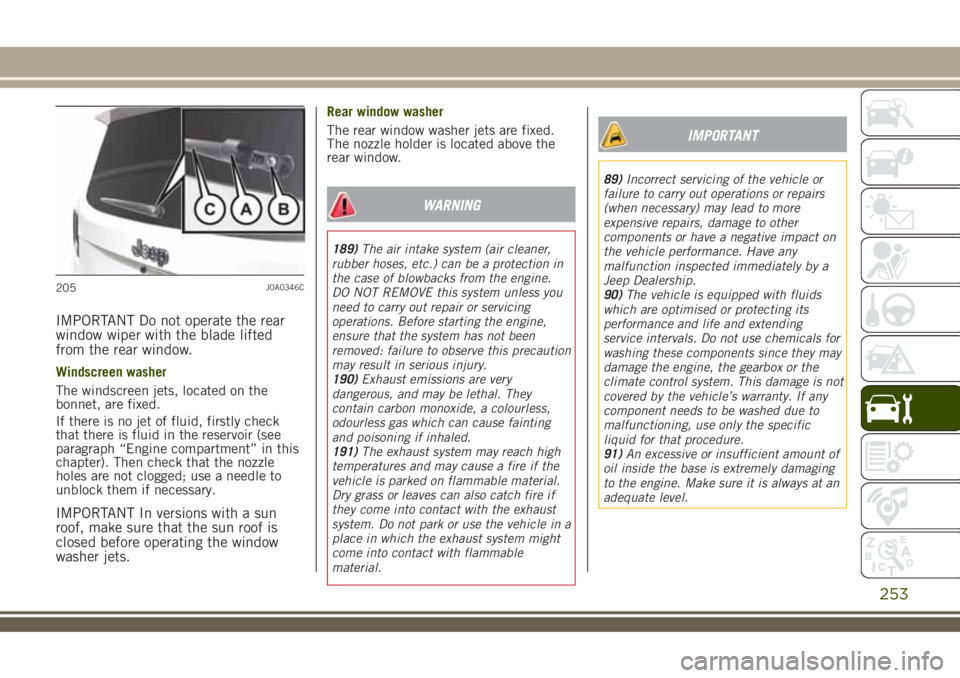
IMPORTANT Do not operate the rear
window wiper with the blade lifted
from the rear window.
Windscreen washer
The windscreen jets, located on the
bonnet, are fixed.
If there is no jet of fluid, firstly check
that there is fluid in the reservoir (see
paragraph “Engine compartment” in this
chapter). Then check that the nozzle
holes are not clogged; use a needle to
unblock them if necessary.
IMPORTANT In versions with a sun
roof, make sure that the sun roof is
closed before operating the window
washer jets.
Rear window washer
The rear window washer jets are fixed.
The nozzle holder is located above the
rear window.
WARNING
189)The air intake system (air cleaner,
rubber hoses, etc.) can be a protection in
the case of blowbacks from the engine.
DO NOT REMOVE this system unless you
need to carry out repair or servicing
operations. Before starting the engine,
ensure that the system has not been
removed: failure to observe this precaution
may result in serious injury.
190)Exhaust emissions are very
dangerous, and may be lethal. They
contain carbon monoxide, a colourless,
odourless gas which can cause fainting
and poisoning if inhaled.
191)The exhaust system may reach high
temperatures and may cause a fire if the
vehicle is parked on flammable material.
Dry grass or leaves can also catch fire if
they come into contact with the exhaust
system. Do not park or use the vehicle in a
place in which the exhaust system might
come into contact with flammable
material.
IMPORTANT
89)Incorrect servicing of the vehicle or
failure to carry out operations or repairs
(when necessary) may lead to more
expensive repairs, damage to other
components or have a negative impact on
the vehicle performance. Have any
malfunction inspected immediately by a
Jeep Dealership.
90)The vehicle is equipped with fluids
which are optimised or protecting its
performance and life and extending
service intervals. Do not use chemicals for
washing these components since they may
damage the engine, the gearbox or the
climate control system. This damage is not
covered by the vehicle’s warranty. If any
component needs to be washed due to
malfunctioning, use only the specific
liquid for that procedure.
91)An excessive or insufficient amount of
oil inside the base is extremely damaging
to the engine. Make sure it is always at an
adequate level.
205J0A0346C
253
Page 257 of 356

WHEELS AND TYRES
SUGGESTIONS ABOUT THE
ROTATION OF THE TYRES
192) 193)97) 98) 99) 100)
The front and rear tyres are subject to
different loads and stress due to steering,
manoeuvres and braking. For this reason
they are subject to uneven wear.
To resolve this problem, tyres should be
rotated at the appropriate time. This
operation is recommended for tyres with
a deep tread pattern, suitable both for
on-road and off-road driving.
Tyre rotation contributes to the
preservation of the grip and traction
performance on wet, muddy or snowy
roads, guaranteeing optimal driveability
of the vehicle.
In the case of irregular wear of the tyres,
the reason must be identified and
corrected before rotating them.
WARNING
192)Do not cross switch the tyres if they
are "unidirectional" type. In this case,
always take care not to fit the tyres with a
direction of rotation that is opposite to
that indicated: you would risk losing grip
and control of the vehicle.
193)Travelling with partially or completely
deflated tyres can cause safety problems
and damage the concerned tyre beyond
repair.
IMPORTANT
97)The road holding qualities of the car
also depend on the correct inflation
pressure of the tyres.
98)If tyre pressure is too low, the tyre may
overheat and be severely damaged as a
result.
99)Do not switch tyres from the
right-hand side of the vehicle to the
left-hand side, and vice versa.100)Never submit alloy rims to repainting
treatments requiring the use of
temperatures exceeding 150°C. The
mechanical properties of the wheels could
be impaired.
SNOW CHAINS
101)
Front-wheel drive and four-wheel drive
versions: 7-mm snow chains can be used
on 215/65 R16 and 215/60 R17 tyres.
Chains cannot be fitted on
225/55 R18 tyres. e di incidenti.
IMPORTANTUse snow chains in
accordance with local regulations of each
country. In certain countries, tyres
marked with code M+S (Mud and Snow)
are considered as winter equipment;
therefore their use is equivalent to that of
the snow chains.
The snow chains may be applied only to
the front wheel tyres.
Check the tension of the snow chains
after the first few metres have been
driven.
Using snow chains with tyres with
non-original dimensions may damage the
vehicle.
Using different size or type (M+S, snow,
etc.) tyres between front and rear axle
may adversely affect vehicle driveability,
255
Page 267 of 356
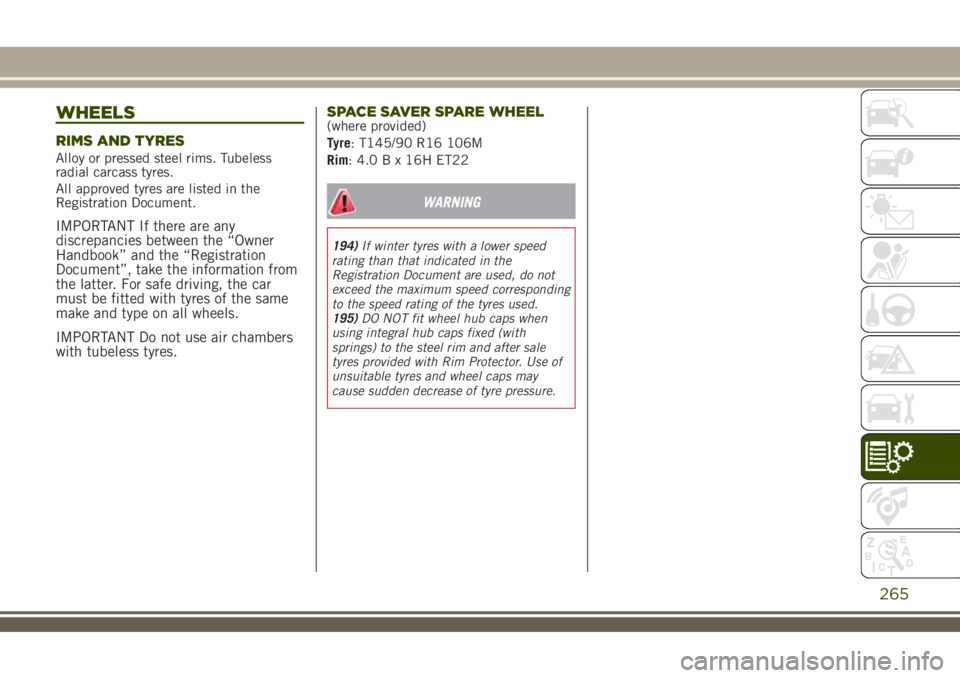
WHEELS
RIMS AND TYRES
Alloy or pressed steel rims. Tubeless
radial carcass tyres.
All approved tyres are listed in the
Registration Document.
IMPORTANT If there are any
discrepancies between the “Owner
Handbook” and the “Registration
Document”, take the information from
the latter. For safe driving, the car
must be fitted with tyres of the same
make and type on all wheels.
IMPORTANT Do not use air chambers
with tubeless tyres.SPACE SAVER SPARE WHEEL
(where provided)
Tyre: T145/90 R16 106M
Rim: 4.0 B x 16H ET22
WARNING
194)If winter tyres with a lower speed
rating than that indicated in the
Registration Document are used, do not
exceed the maximum speed corresponding
to the speed rating of the tyres used.
195)DO NOT fit wheel hub caps when
using integral hub caps fixed (with
springs) to the steel rim and after sale
tyres provided with Rim Protector. Use of
unsuitable tyres and wheel caps may
cause sudden decrease of tyre pressure.
265
Page 276 of 356
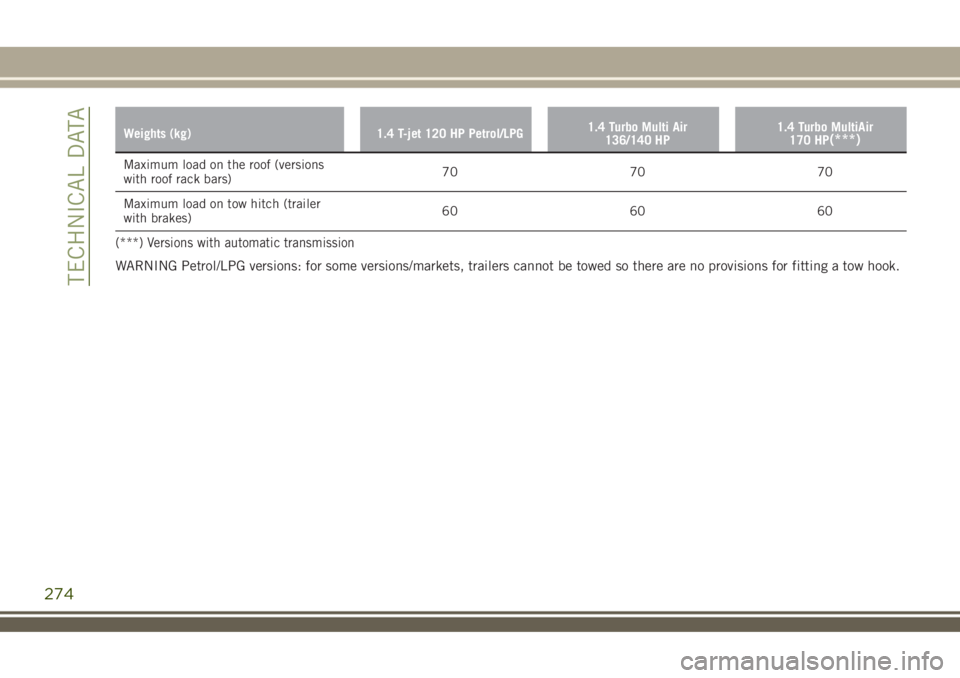
Weights (kg) 1.4 T-jet 120 HP Petrol/LPG1.4 Turbo Multi Air
136/140 HP1.4 Turbo MultiAir
170 HP(***)
Maximum load on the roof (versions
with roof rack bars)70 70 70
Maximum load on tow hitch (trailer
with brakes)60 60 60
(***) Versions with automatic transmission
WARNING Petrol/LPG versions: for some versions/markets, trailers cannot be towed so there are no provisions for fitting a tow hook.
274
TECHNICAL DATA
Page 297 of 356
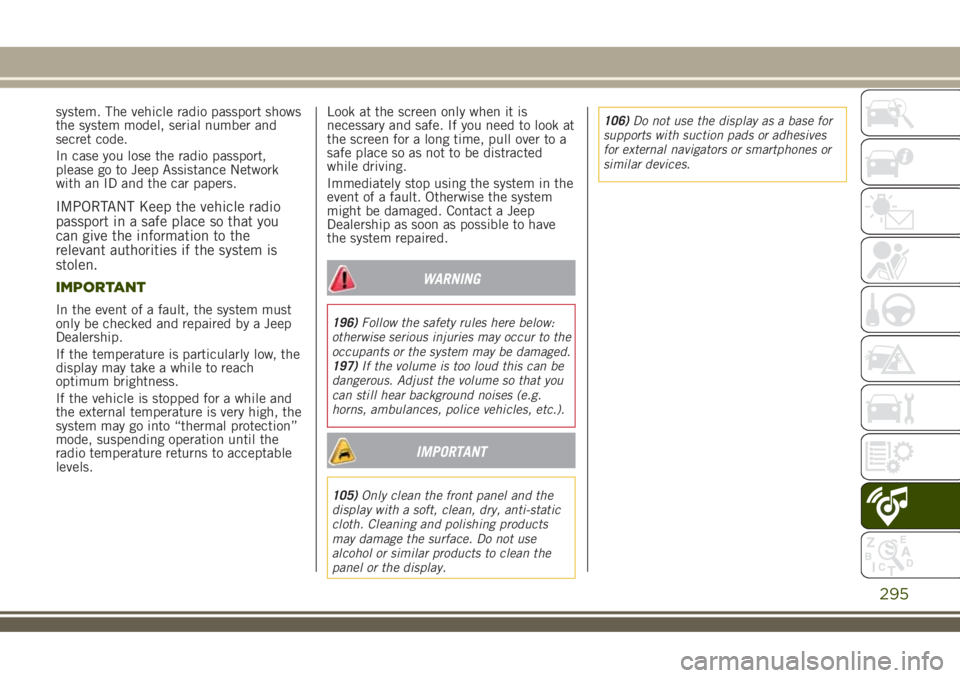
system. The vehicle radio passport shows
the system model, serial number and
secret code.
In case you lose the radio passport,
please go to Jeep Assistance Network
with an ID and the car papers.
IMPORTANT Keep the vehicle radio
passport in a safe place so that you
can give the information to the
relevant authorities if the system is
stolen.
IMPORTANT
In the event of a fault, the system must
only be checked and repaired by a Jeep
Dealership.
If the temperature is particularly low, the
display may take a while to reach
optimum brightness.
If the vehicle is stopped for a while and
the external temperature is very high, the
system may go into “thermal protection”
mode, suspending operation until the
radio temperature returns to acceptable
levels.Look at the screen only when it is
necessary and safe. If you need to look at
the screen for a long time, pull over to a
safe place so as not to be distracted
while driving.
Immediately stop using the system in the
event of a fault. Otherwise the system
might be damaged. Contact a Jeep
Dealership as soon as possible to have
the system repaired.
WARNING
196)Follow the safety rules here below:
otherwise serious injuries may occur to the
occupants or the system may be damaged.
197)If the volume is too loud this can be
dangerous. Adjust the volume so that you
can still hear background noises (e.g.
horns, ambulances, police vehicles, etc.).
IMPORTANT
105)Only clean the front panel and the
display with a soft, clean, dry, anti-static
cloth. Cleaning and polishing products
may damage the surface. Do not use
alcohol or similar products to clean the
panel or the display.106)Do not use the display as a base for
supports with suction pads or adhesives
for external navigators or smartphones or
similar devices.
295
Page 306 of 356
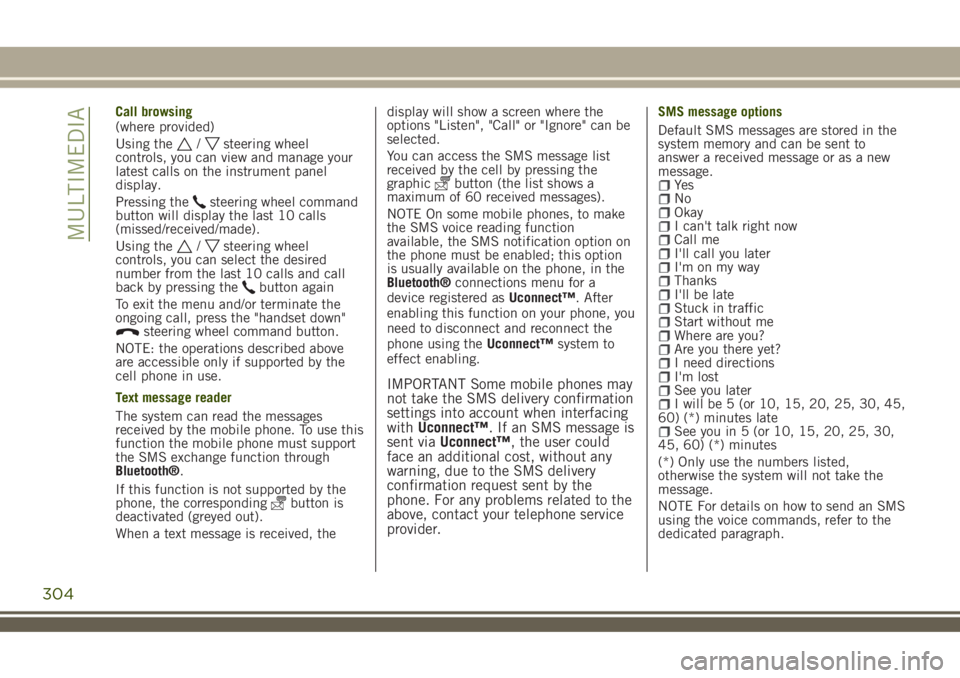
Call browsing
(where provided)
Using the
/steering wheel
controls, you can view and manage your
latest calls on the instrument panel
display.
Pressing the
steering wheel command
button will display the last 10 calls
(missed/received/made).
Using the
/steering wheel
controls, you can select the desired
number from the last 10 calls and call
back by pressing the
button again
To exit the menu and/or terminate the
ongoing call, press the "handset down"
steering wheel command button.
NOTE: the operations described above
are accessible only if supported by the
cell phone in use.
Text message reader
The system can read the messages
received by the mobile phone. To use this
function the mobile phone must support
the SMS exchange function through
Bluetooth®.
If this function is not supported by the
phone, the corresponding
button is
deactivated (greyed out).
When a text message is received, thedisplay will show a screen where the
options "Listen", "Call" or "Ignore" can be
selected.
You can access the SMS message list
received by the cell by pressing the
graphic
button (the list shows a
maximum of 60 received messages).
NOTE On some mobile phones, to make
the SMS voice reading function
available, the SMS notification option on
the phone must be enabled; this option
is usually available on the phone, in the
Bluetooth®connections menu for a
device registered asUconnect™. After
enabling this function on your phone, you
need to disconnect and reconnect the
phone using theUconnect™system to
effect enabling.
IMPORTANT Some mobile phones may
not take the SMS delivery confirmation
settings into account when interfacing
withUconnect™. If an SMS message is
sent viaUconnect™, the user could
face an additional cost, without any
warning, due to the SMS delivery
confirmation request sent by the
phone. For any problems related to the
above, contact your telephone service
provider.
SMS message options
Default SMS messages are stored in the
system memory and can be sent to
answer a received message or as a new
message.
Ye sNoOkayI can't talk right nowCall meI'll call you laterI'm on my wayThanksI'll be lateStuck in trafficStart without meWhere are you?Are you there yet?I need directionsI'm lostSee you laterI will be 5 (or 10, 15, 20, 25, 30, 45,
60) (*) minutes late
See you in 5 (or 10, 15, 20, 25, 30,
45, 60) (*) minutes
(*) Only use the numbers listed,
otherwise the system will not take the
message.
NOTE For details on how to send an SMS
using the voice commands, refer to the
dedicated paragraph.
304
MULTIMEDIA
Page 309 of 356
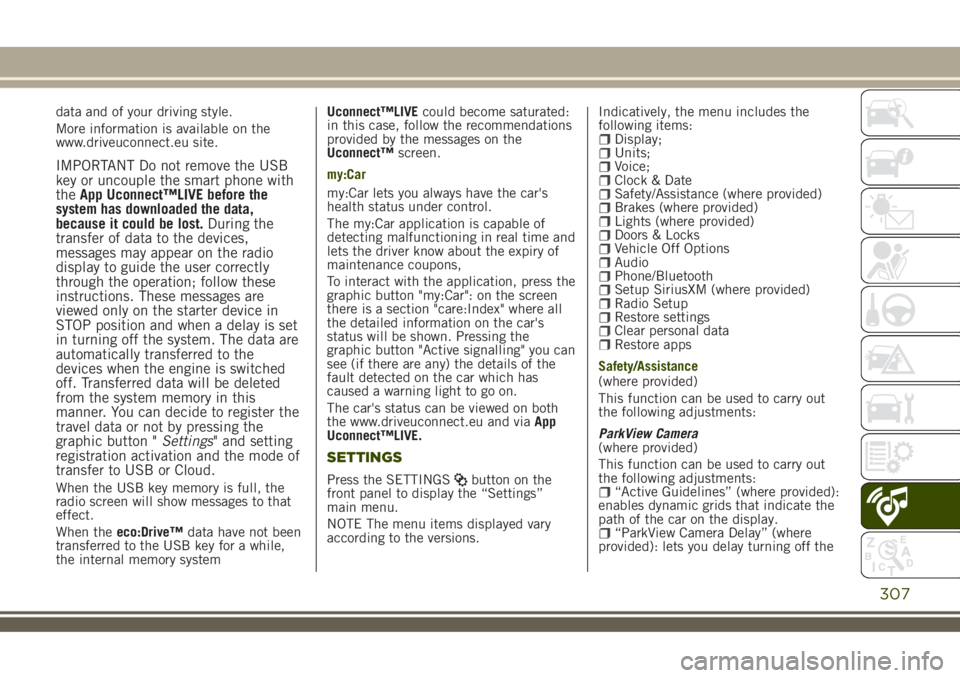
data and of your driving style.
More information is available on the
www.driveuconnect.eu site.
IMPORTANT Do not remove the USB
key or uncouple the smart phone with
theApp Uconnect™LIVE before the
system has downloaded the data,
because it could be lost.During the
transfer of data to the devices,
messages may appear on the radio
display to guide the user correctly
through the operation; follow these
instructions. These messages are
viewed only on the starter device in
STOP position and when a delay is set
in turning off the system. The data are
automatically transferred to the
devices when the engine is switched
off. Transferred data will be deleted
from the system memory in this
manner. You can decide to register the
travel data or not by pressing the
graphic button "Settings" and setting
registration activation and the mode of
transfer to USB or Cloud.
When the USB key memory is full, the
radio screen will show messages to that
effect.
When theeco:Drive™data have not been
transferred to the USB key for a while,
the internal memory systemUconnect™LIVEcould become saturated:
in this case, follow the recommendations
provided by the messages on the
Uconnect™screen.
my:Car
my:Car lets you always have the car's
health status under control.
The my:Car application is capable of
detecting malfunctioning in real time and
lets the driver know about the expiry of
maintenance coupons,
To interact with the application, press the
graphic button "my:Car": on the screen
there is a section "care:Index" where all
the detailed information on the car's
status will be shown. Pressing the
graphic button "Active signalling" you can
see (if there are any) the details of the
fault detected on the car which has
caused a warning light to go on.
The car's status can be viewed on both
the www.driveuconnect.eu and viaApp
Uconnect™LIVE.
SETTINGS
Press the SETTINGSbutton on the
front panel to display the “Settings”
main menu.
NOTE The menu items displayed vary
according to the versions.Indicatively, the menu includes the
following items:
Display;Units;Voice;Clock & DateSafety/Assistance (where provided)Brakes (where provided)Lights (where provided)Doors & LocksVehicle Off OptionsAudioPhone/BluetoothSetup SiriusXM (where provided)Radio SetupRestore settingsClear personal dataRestore apps
Safety/Assistance
(where provided)
This function can be used to carry out
the following adjustments:
ParkView Camera
(where provided)
This function can be used to carry out
the following adjustments:
“Active Guidelines” (where provided):
enables dynamic grids that indicate the
path of the car on the display.
“ParkView Camera Delay” (where
provided): lets you delay turning off the
307
Page 310 of 356
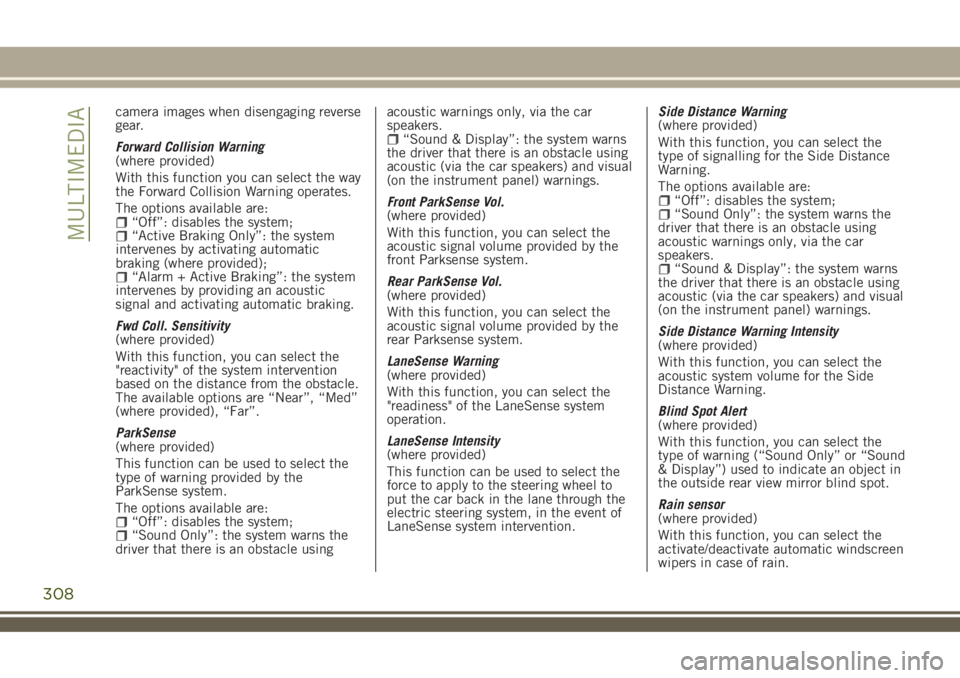
camera images when disengaging reverse
gear.
Forward Collision Warning
(where provided)
With this function you can select the way
the Forward Collision Warning operates.
The options available are:
“Off”: disables the system;“Active Braking Only”: the system
intervenes by activating automatic
braking (where provided);
“Alarm + Active Braking”: the system
intervenes by providing an acoustic
signal and activating automatic braking.
Fwd Coll. Sensitivity
(where provided)
With this function, you can select the
"reactivity" of the system intervention
based on the distance from the obstacle.
The available options are “Near”, “Med”
(where provided), “Far”.
ParkSense
(where provided)
This function can be used to select the
type of warning provided by the
ParkSense system.
The options available are:
“Off”: disables the system;“Sound Only”: the system warns the
driver that there is an obstacle usingacoustic warnings only, via the car
speakers.
“Sound & Display”: the system warns
the driver that there is an obstacle using
acoustic (via the car speakers) and visual
(on the instrument panel) warnings.
Front ParkSense Vol.
(where provided)
With this function, you can select the
acoustic signal volume provided by the
front Parksense system.
Rear ParkSense Vol.
(where provided)
With this function, you can select the
acoustic signal volume provided by the
rear Parksense system.
LaneSense Warning
(where provided)
With this function, you can select the
"readiness" of the LaneSense system
operation.
LaneSense Intensity
(where provided)
This function can be used to select the
force to apply to the steering wheel to
put the car back in the lane through the
electric steering system, in the event of
LaneSense system intervention.Side Distance Warning
(where provided)
With this function, you can select the
type of signalling for the Side Distance
Warning.
The options available are:
“Off”: disables the system;“Sound Only”: the system warns the
driver that there is an obstacle using
acoustic warnings only, via the car
speakers.
“Sound & Display”: the system warns
the driver that there is an obstacle using
acoustic (via the car speakers) and visual
(on the instrument panel) warnings.
Side Distance Warning Intensity
(where provided)
With this function, you can select the
acoustic system volume for the Side
Distance Warning.
Blind Spot Alert
(where provided)
With this function, you can select the
type of warning (“Sound Only” or “Sound
& Display”) used to indicate an object in
the outside rear view mirror blind spot.
Rain sensor
(where provided)
With this function, you can select the
activate/deactivate automatic windscreen
wipers in case of rain.
308
MULTIMEDIA